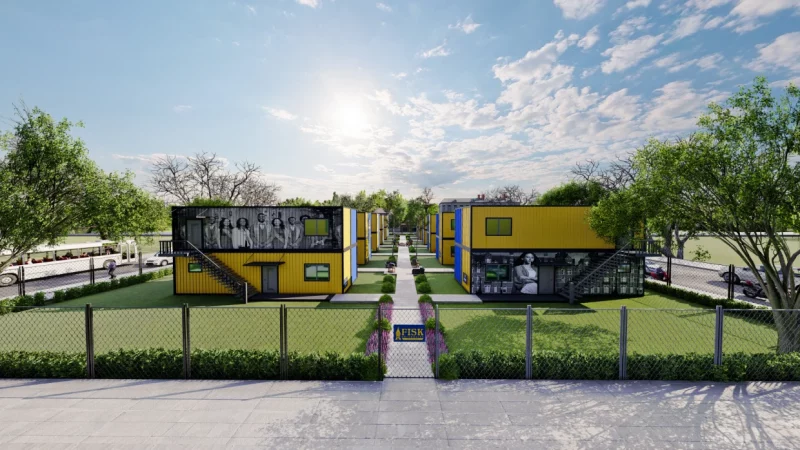HBCUs are getting creative to meet growing student housing demand
Share
Explore Our Galleries
Breaking News!
Today's news and culture by Black and other reporters in the Black and mainstream media.
Ways to Support ABHM?
By Char Adams, NBC News

Historically Black colleges and universities have been embroiled in a student housing crisis for decades. Now, some are getting creative to address the problem.
Just in time for the fall 2023 semester, Fisk University in Nashville, Tennessee, will transform dozens of shipping containers into dorm rooms, forming a small residential community that will house 98 students, university Executive Vice President Jens Frederiksen told NBC News. The low-cost, easily manufactured dorms will have blue and gold exteriors — the university’s colors — with private bathrooms, kitchenettes and showers inside. The project will cost about $4 million, Frederiksen said.
“I think this is a brilliant and innovative solution and it works for us,” Frederiksen said. Fisk is believed to be the second U.S. higher education institution to utilize shipping containers for student housing after the College of Idaho implemented dorm-style containers in 2020. Although shipping containers have been used for everything from housing to urban farming in the U.S., colleges and universities have only recently turned to the solution to meet student population needs.
“The enrollment is growing so fast, and the shipping containers provide some sustainable flexibility. We have four current residence halls, but they are aging dormitories. So I think the containers will serve as a sustainable solution for the foreseeable future,” Frederiksen said.
The housing crisis at HBCUs is long-standing and well documented: There isn’t enough housing available to accommodate rising HBCU enrollment, students endure poor living conditions on some campuses, and off-campus housing is largely inaccessible.
Fisk is one of several HBCUs working to provide housing accommodations for a rising number of students as HBCUs are seeing a modest increase in enrollment after years of decline. Applications at HBCUs have spiked in recent years, according to a report from Inside Higher Ed. And in fall 2021, Morehouse College in Atlanta saw a 70% increase in new students compared with fall 2020, with residential student applications increasing by 17% between 2020 and 2021, according to the school’s website. Even smaller schools like Cheyney University in Pennsylvania, which lost 38% of its student body during the 2017-2018 school year, saw a 50% increase in enrollment from 2018 to 2022, according to the school’s website. As for Fisk, the small liberal arts university saw its total enrollment jump from 630 to 1,050 in just under five years, Frederiksen said.
This is good news after HBCUs saw their lowest enrollment in nearly 20 years during the 2018-2019 school year. But it’s also spelled trouble for the historically underfunded schools as they’ve struggled to house the new students.
HBCUs were founded to give Black students an opportunity for a higher education — and, in turn, upward mobility — when most colleges were segregated. But decades of underfunding, exacerbated by national economic downturns, have laid the groundwork for the current housing crisis, experts say. For example, Tennessee State University reportedly put some students up in hotels ahead of the fall 2022 semester and invited students to take classes online at a free or discounted rate as officials worked to address housing issues.
Bellamy details the housing struggles at Howard University, too.
HBCUs like these help make higher education attainable for Black students and play an important role in racial justice.
ABHM’s breaking news archive has more stories like this.











Comments Are Welcome
Note: We moderate submissions in order to create a space for meaningful dialogue, a space where museum visitors – adults and youth –– can exchange informed, thoughtful, and relevant comments that add value to our exhibits.
Racial slurs, personal attacks, obscenity, profanity, and SHOUTING do not meet the above standard. Such comments are posted in the exhibit Hateful Speech. Commercial promotions, impersonations, and incoherent comments likewise fail to meet our goals, so will not be posted. Submissions longer than 120 words will be shortened.
See our full Comments Policy here.